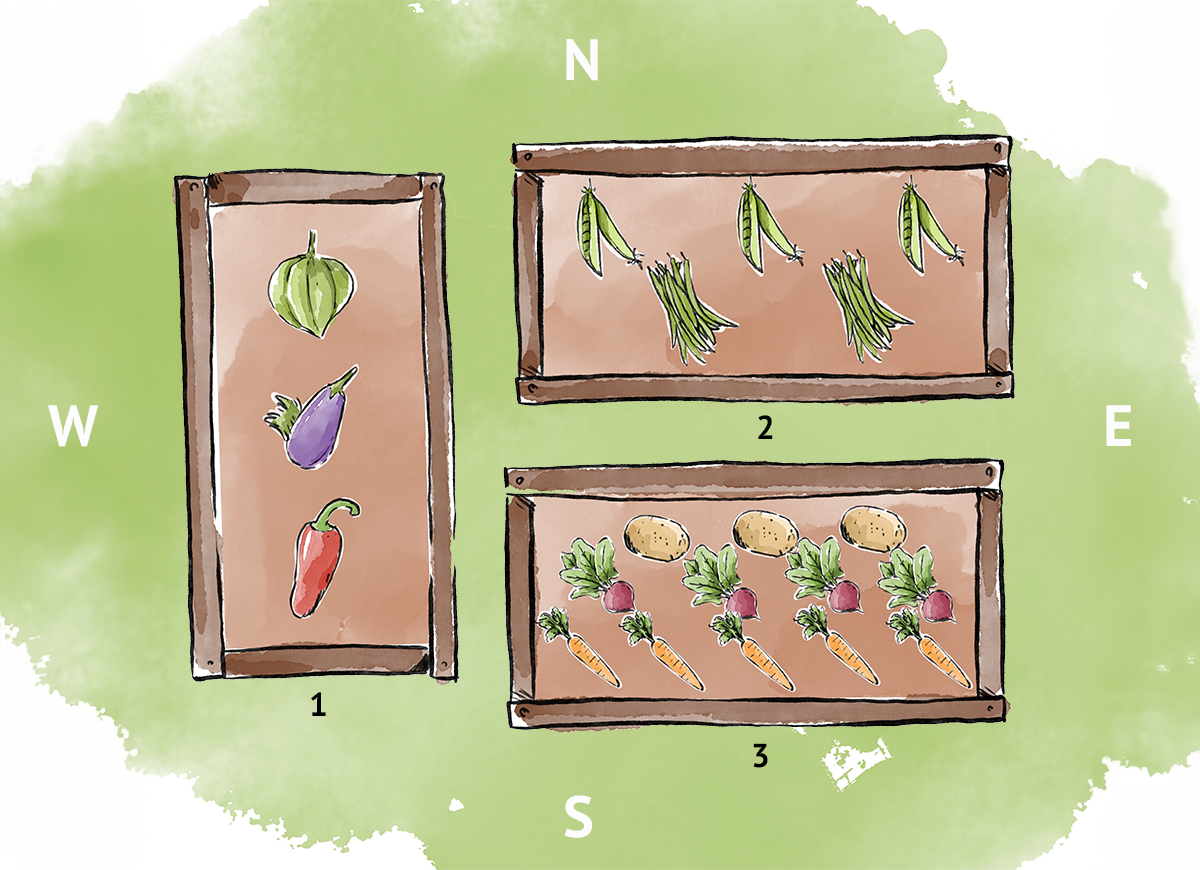We may earn revenue from the products available on this page and participate in affiliate programs. Learn More ›
Figuring out the right vegetable garden layout for your yard can take some time. Sunlight, spacing, and soil structure all need to be considered, but you also have to think about which types of plants you enjoy eating and growing, your local climate and weather patterns, and whether the plants you’ve chosen are well suited for your growing location.
Vegetables are typically grown in in-ground gardens, but if you’re working with a small space or a tricky soil type, you may want to try growing veggies in raised garden beds or containers. And, of course, square-foot gardening and vertical gardening can also help you squeeze more veggies into a limited area.
Whether you’re looking for creative ways to fit more food crops into veggie beds or you’re just curious about garden layout ideas that will make smart use of your soil, this guide contains tricks for container gardens and larger plots, raised garden bed planning tips, planting suggestions, and other info that will help you plan a vegetable garden the easy way.
Top Priorities for Planning a Vegetable Garden Layout
One of the most important steps in garden planning is taking a thorough inventory of the space you’re working with. That means determining how much light your garden receives and how much available space you have for growing, but Dorcas Corrow from Sweet Haven Harvest for Hunger, a volunteer food garden in Seal Cove, Maine, also recommends taking a careful look at your soil type.
Before you plant a vegetable garden, she suggests that it’s important to always “send soil samples to your cooperative extension soil testing laboratory and follow their recommendations for soil amendments.” This will ensure your plants are growing in the best soil possible.
Light
When looking for a spot for your backyard vegetable garden, choose a location that receives at least 6 hours of bright light daily. Most vegetables and fruit require full sun to grow, but if you have a shadier space, you can experiment with edible crops like turmeric and root veggies, which are plants that can tolerate light shade.
Space
Vegetable gardens can be any size you like, and you can even grow many vegetables in small pots on a balcony or outdoor patio. However, it’s important to research the types of plants you’d like to grow and make sure your garden will provide enough room to keep those specific plants happy. A 10-foot by 10-foot garden is a good size for most beginning growers, but you may need even more room if you want to grow sprawling plants such as big carving pumpkins.
Plants
When selecting plants for your vegetable garden, Corrow emphasizes one key piece of advice: “Do not waste garden space on things you will not eat!” Vegetable gardens of any size can only fit a limited number of plants, so save room for the plants you often purchase from the grocery store and use in your cooking.
If you’re working with a small garden or growing in containers, look for bush-type or determinant-growing plants, which have a more compact growth habit. Or select climbing plant varieties and train them to grow up trellises for space savings. If you have a successful growing season and gather more produce than you can use fresh, try canning or dehydrating your surplus, or, says Carrow, “donate it to your local food pantry.”
For even more vegetable garden ideas, you may want to explore these gardening techniques as well:
- Companion planting: A simple organic gardening method, companion planting involves growing certain plants together for pest control and other benefits. Strongly scented herbs, like oregano, basil, chives, and dill, are some of the best companion plants for veggies, but they’re even more beneficial if you allow them to flower. Marigolds, nasturtiums, zinnias, borage, and sweet alyssum make fantastic vegetable companions, too.
- Succession planting: If you want to grow even more veggies in a small space, succession planting is the way to go. Simply sow fast-growing seeds (like radishes, carrots, and lettuce) every 2 to 4 weeks for a harvest that keeps coming.
- Crop rotation: “Do not plant the same crop in the same place every year,” advises Corrow. Instead, she says, it’s a good idea to “try to establish a 4-year cycle for moving crops around the garden.” This simple planting technique, known as crop rotation, can help control soil-dwelling pests and reduce plant diseases. You can keep track of your planting arrangements in a notebook or vegetable garden planner so you don’t forget what you planted where.
In-Ground Vegetable Patch

If you’re new to in-ground vegetable gardening, start out with a small 75- or 100-square-foot garden and expand from there if needed. Square or rectangular beds laid out in a north to south direction will maximize sunlight and help plants grow even better. To keep veggies from growing in shade, locate vining plants on trellises and tall plants like corn toward the north side of the garden, and plant shorter crops, like radishes, strawberries, and lettuce, toward the south.
Companion planting with a ring of marigolds, onions, or chives around the perimeter of your garden can take your backyard vegetable garden ideas to the next level and make your crops less vulnerable to pests. You may also want to experiment with drip irrigation, garden walkways, and mulching to prevent soil compaction, automate watering, and prevent weeds from sneaking in.
Raised Garden Beds

Planning a raised bed garden is very similar to in-ground gardening in that raised beds are typically laid out in a north-south orientation, and shorter plants are grown toward the south. Raised gardens are usually made of wood or metal. They can be as long as needed, but it’s best to keep them no wider than 3 to 4 feet across to make weeding and planting easier.
Many gardeners keep three or more raised beds at a time and rotate plant families in between each bed to keep pests in check. For example, during the first year, nightshades would be planted in bed No. 1, legumes in bed No. 2, and root crops in bed No. 3. The following year, each plant family would be moved to a different bed to avoid overwintering pests.
Square-Foot Gardening

Technically square-foot gardening can be practiced in raised beds or in-ground gardens of any size; however, most growers use square-foot gardening in 4-foot by 4-foot raised beds. Growing tall and trellised plants, like tomatoes and beans, toward the north side of the garden will avoid lighting issues. Planting smaller plants, like root veggies and lettuce, toward the south and perimeter of the garden will make harvesting easier.
Specific spacing recommendations should be followed carefully with square-foot gardening to ensure plants have enough room to grow. For example, large plants like tomatoes will need their own square foot of growing space, but you can sow 16 carrots or radishes in each square. And don’t forget that succession sowing seeds throughout the season can help you get even more food out of a square foot of growing space.
Container Vegetable Garden

Small-space and urban growers have found lots of creative ways to fit more food crops in a limited area. Vertical growing with trellising is one option, but many vegetables can also be grown in pots, grow bags, grow towers, railing planters, and hanging baskets for space savings. Be sure to select pots with plenty of drainage holes, and opt for bush-type beans and cucumbers or determinate tomatoes to keep plants more manageable.
If you’re maintaining just a few large pots on a balcony, try growing large plants like tomatoes and peppers toward the center of your pots and companion plant with basil and other smaller herbs for natural pest control. For more veggie garden ideas, consider keeping smaller root crops in roomy and deep pots and mix and match your setup with a hanging basket filled with trailing strawberries or a medley of colorful lettuce, kale, and herbs planted in a spacious terra-cotta pot. Even larger plants, like sugar pie pumpkins, can be kept in a container garden as long as you use a minimum 20-gallon grow bag and keep the vines tidy with a trellis and careful pruning.

